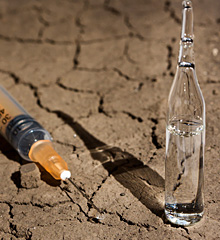 To the average person, desert soils can appear to be dry, lifeless environments. Research conducted by Fred Rainey and his colleagues on microbial biodiversity dispels this myth and offers insight into characteristics of some bacteria found in arid environments.
To the average person, desert soils can appear to be dry, lifeless environments. Research conducted by Fred Rainey and his colleagues on microbial biodiversity dispels this myth and offers insight into characteristics of some bacteria found in arid environments.
Rainey’s lab at Louisiana State University analyzed the ionizing-radiation fractions of soil bacterial communities in a soil sample taken from the CAP LTER study area. Previous research had suggested that ionizing-radiation resistance is not simply an adaptation to environmental radiation. Rainey and his colleagues hypothesized that DNA repair mechanisms have evolved to compensate for desiccation, a stress producing a pattern of DNA damage similar to that of ionizing radiation.
To test this hypothesis, researchers compared the ionizing-radiation fractions of soil bacterial communities in samples taken from the Sonoran Desert and a Louisiana forest. They recovered bacterial isolates surviving doses of 30 kGy from the Sonoran Desert soil, whereas no bacteria in the Louisiana forest soil survived doses greater than 13 kGy. The study results were consistent with the hypothesis that organisms with heightened DNA repair capacity are among the species that have a selective advantage in arid environments.
Analysis of the Sonoran Desert sample revealed that strains related to the taxonomic groups Bosea, Chelatococcus, Corbulabacter, and Geodermatophilus, Planococcus (species of the family Sphingomonadaceae) and Spirosoma were resistant to gamma radiation, a new finding. Researchers also recovered a high number of Deinococcus isolates from a soil sample exposed to high ionizing-radiation levels, which confirmed that species of this genus are very ionizing-radiation resistant. Through genetic sequencing, the researchers established that nine new species of the genus Deinococcus were present in the soil taken from the Sonoran Desert: D. hohokamensis, D. navajonensis, D. hopiensis, D. apachensis, D. maricopensis, D. pimensis, D. yavapaiensis, D. papagonensis, and D. sonorensis.
Little is known about the microbial diversity in arid environments, and there are few data about the abundance or diversity of ionizing-radiation resistant bacteria in these environments. Work by Rainey and his colleagues contributes greatly to knowledge about bacterial communities in arid environments and indicates direction for additional research on ionizing-radiation resistant bacteria.
References
Rainey, F.A., K. Ray, M. Ferreira, B. Gatz, M.F. Nobre, D. Bagaley, B. Rash, M.-J. Park, A. Earl, N. Shank, A. Small, M. Henk, J. Battista, P. Kämpfer, and M. da Costa. 2005. Extensive diversity of ionizing-radiation-resistant bacteria recovered from Sonoran Desert soil and description of nine new species of the genus Deinococcus obtained from a single soil sample. Applied and Environmental Microbiology 71(9):5225-5235.


